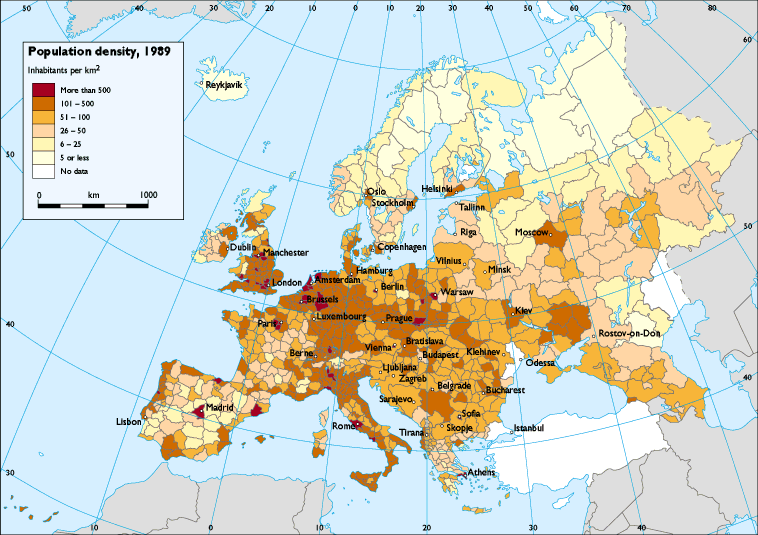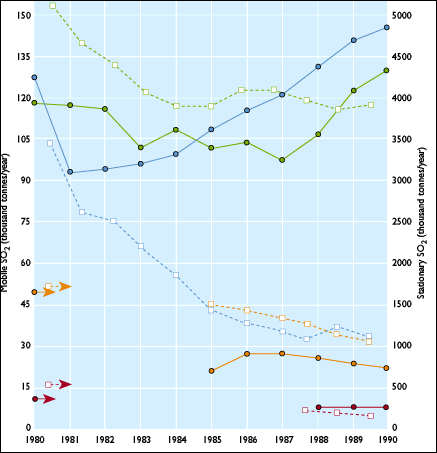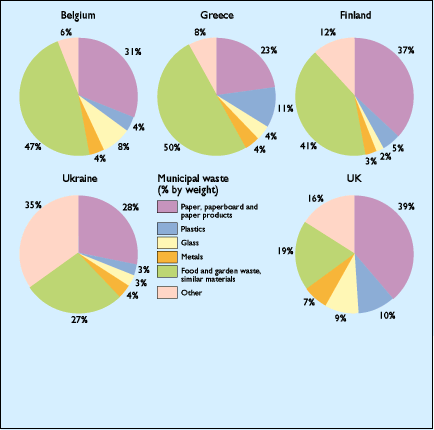12 Population, production and
consumption
 |
Population density, 1989 |
Examines the complex and still poorly understood
relationship between people, resources and development attempt to
clarify the issues involved. The chapter concludes by stressing the
importance of assessing the environment implications of long-term
economic and development programmes
- 12.8% of the world population are Europeans, a
proportion which is decreasing because of lowered fertility in most
European countries
- adjusted living standards vary by a factor of
more than four between Eastern and Western Europe
- most Central and Eastern European countries
rely food imports - Western European countries import much animal
feed
| |
|
Coal |
Oil |
Gas |
Nuclear |
Hydro |
Others |
| World |
1970 |
31.7 |
46.8 |
18.8 |
0.9 |
1.7 |
|
| 1990 |
28.5 |
40.5 |
22.2 |
6.3 |
2.5 |
|
| Western
Europe |
1970 |
27.6 |
60.3 |
6.3 |
1.2 |
3.0 |
1.6 |
| 1990 |
19.3 |
44.0 |
16.6 |
14.4 |
3.0 |
2.7 |
| Eastern
Europe |
1970 |
60.1 |
23.3 |
13.1 |
|
1.0 |
2.4 |
| 1990 |
48.4 |
24.2 |
20.1 |
4.5 |
1.1 |
1.6 |
| Former
USSR |
1970 |
36.8 |
34.8 |
22.3 |
0.2 |
1.6 |
4.3 |
| 1990 |
21.0 |
30.0 |
42.0 |
4.0 |
1.6 |
1.3 |
World and European primary energy consumption
1970-90 (tonnes of oil equivalent, %)
13 Exploitation of natural
resources
Explores the differences between renewable
(water, forests and crops) and non-renewable (fossil fuels and metal
ores) resources. International trade and the growing interdependence of
nations have made the sustainable management of these resources a
global issue. The chapter focuses on major developments in the use of
resources in Europe and reviews the statistics used to monitor resource
use.
- Europe has 8% of worldwide renewable
fresh-water resources but accounts for 15% of withdrawals
- although Europe (excluding the former USSR)
had 1.9 million hectares more forest and wooded land in 1990 than in
1981, atmospheric pollution and uncontrolled logging (Russian
Federation) are causing forest loss and damage
- Europe has depleted most of its high-grade
mineral reserves and now relies mostly on imports, mainly from
Africa
14 Emissions
Presents an overview of emissions to air and water
in Europe: their physico-chemical characteristics, magnitude, pathways
and sinks. The overview of atmospheric emissions of major pollutants in
European countries is based on data reported to UNECE al where
available, on Corinair 1990. The analysis of emissions to water is
based on the limited quantitative information available and focuses on
emissions from agriculture and wastewater. Sol examples illustrate the
contribution of industry as a source of emissions to the aquatic
environment. Existing emission inventories in European countries are
examined; they highlight the need for an integrated means of collecting
data on emission and waste to all media, and the need to harmonize
emission inventory methodologies at the European level.
- Europe accounts for between 20 and 30% of
global human-induced emissions of CO2, SO2, VOCs and nitrogen
oxides
- in densely populated areas about half of the
phosphorus discharged to surface water is related to sewage
discharges
 |
Sulphur dioxide emission
trends |
| |
15 Waste
Analyses present trends in waste production in
Europe, and assesses the potential threats to human health and the
environment resulting from current waste management practices. Current
patterns of transfrontier movements of hazardous waste across European
countries are examined. The options to reduce waste and recycle
materials through integrated; processes are presented for a number of
waste streams. The assessment is based on up-to-date information from a
joint OECD/Eurostat survey and state of the environment report The
limited availability, quality and comparability of existing waste
statistics highlight the importance of harmonizing was classification
systems at the European level.
 |
Composition of municipal waste,
1990 |
- on average, Europeans produce 350 kg of
municipal waste per capita per year
- an increasing amount of industrial waste is
considered hazardous
- high production rates offset efforts towards
waste minimization and recycling
- European waste dumps cover between 1 200 and 1
700 km2, while there are 2 000 km2 of derelict industrial
land
16 Noise and radiation
Reviews the main impacts of the important 'physical
fields' in Europe - environmental noise, ionizing and non-ionizing
radiation - and relates them to main sources. Noise data from
international sources (OECD and WHO) are presented and analysed
wherever possible, to give the overall situation in Europe and in
individual countries. Non-ionizing radiation deals with electromagnetic
fields and ultraviolet radiation. The main sources and effects of
ionizing radiation - natural and artificial - in Europe are
described.
- in the highly industrialized countries of
Europe more than 50% of the population is exposed to noise levels from
traffic which exceed the level at which people become seriously annoyed
during the daytime
- about 113 million Europeans -17% of the
population - are exposed to levels of noise that have serious negative
impacts
- overexposure to ultraviolet radiation is so
far due mostly to lifestyle; there are indications of a 5% increase in
W-B radiation in winter in the northern hemisphere
- radon exposure is estimated to cause 10 000
cancer deaths a year in Europe
17 Chemicals and genetically modified
organisms
The manufacture, marketing and use of chemicals
result in the release of many compounds to the environment, often with
undesirable effects on human health, welfare and ecosystems. The
sources of these compounds are described, as are the impacts of
selected chemicals of concern. The use of genetically modified
organisms in EU countries is also examined, with their potential
undesirable effects and the procedures in place to control their safe
use
 |
| Field releases of GMOs notified in the
EU in 1991-94 |
- about 100 000 chemicals are marketed in the
EU, and between 200 and 300 new ones appear each year
- between 1991 and 1994, nearly 300
notifications of field releases of genetically modified organisms were
made in the EU
18 Natural and technological
hazards
Examines the characteristics and importance of
accidents and natural hazards as causes of environmental impacts. Their
causes and consequences in Europe are summarized, and the different
types of damage that can be produced are identified. Examples are given
of industrial accidents (Flixborough and Seveso, for example),
transport accidents, marine accidents and nuclear accidents (as at
Chernobyl). Natural hazards such as storms and floods, heatwaves, fires
and droughts also impact the environment and are potentially
exacerbated by human activities.

Caesium contamination
around Tschernobyl after the accident
- from a major industrial accidents reporting
system, appears that the most accidents occurred in the petroleum
industry, and that highly flammable gases and chlorine were the
substances most often involve
- tanker accidents contribute only about 10-15%
of a the oil that reaches the sea as a result of human
activity
- precise knowledge of the full consequences of
the Chernobyl nuclear accident is unlikely, but some unexpected effects
have already emerged
- natural hazards are having an increased impact
on human settlements, probably because of the greater number of
settlements and their increased vulnerable due to their uncontrolled
extension into high risk areas.






Document Actions
Share with others